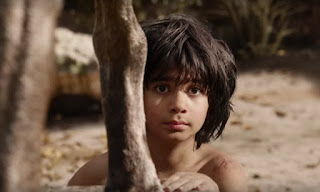So, how did MPC create this most extraordinarily ambitious movie?
Ben Jones - CG Supervisor
Ben Jones was "character supervisor" for the film, overseeing the building of the CG models, muscles, fur - "that sort of thing". It was "quite a special project", because the only "filmed element in the film was Mowgli", so it was "very close to being a CG feature", with the entire set being digital.
A CG film that looks like it's live action
Everything on this film is "hand-made", all hand-keyframed. The project took two years, with at least 800 artists working in London, Los Angeles and Bangalore, doing around 1,200 shots. The approach laid down by Jon Favreau was a "photo-real target look", and the film was all "pre-vis'ed" in advance.
It's a "talking animals movie", and animals don't talk, so they had to "suspend disbelief", and make this work. They wanted a key-framed pipeline, like the old Disney days, without too much MoCap. This was a nod to the traditional Disney way of doing things - all hand made.
What does Virtual production mean?
 |
| Mowgli. The only bit that isn't CG |
Every shot on the film had this "tech-viz" pass, to enable the filmed work and CG work to integrate seamlessly. Each shot also included 3D stereo, so it "worked in 3D', with an "immersive experience".
Software
There were "lots of different software packages used, such as Flowline, and also in-house tools, to create the seamlessly integrated final look of the film. They created a library of authentic plant assets, all hand-modelled to be as realistic as possible.
Rendering
"Millions upon millions of blades of grass" had to be rendered, ray-traced, and this was "very difficult", and took "a very long time". Even the rivers were built in CG - and the interactions with the animals all had to be made to look photo-real.
Mowgli acting
The actor who played Mowgli - Neel Sethi - did a lot of acting on set with real puppets - big stuffed toys, to make sure that the interaction was all there.
Animation
MPC had an "amazing animation team", and everything was hand-animated. They began with concept art, and sculpts, and animation tests. They "always used reference", focusing on real wildlife footage to inform the facial expressions and body animation.
 |
| Bagheira |
In the end, the rigs "need to be highly dependable" - so you can do thousands of shots on the film. And all the animals "had to do a screen test", just "like an actor would". And Jon Favreau gave notes on their performance. So each animal "was cast in the film", with "no exceptions".
Realism is "very hard" with cats - because audiences are "so familiar with them". So the tricky thing is that "you don't have any license - it had to be realistic". Are we there yet? Is the result really fully photo-real? Not quite.
They did Bagheira first, got that right, and then did the others. The animators "did thousands of motion cycles" creating a "library-based approach" that was "not shot-specific". The tiger, for example, is a "bag of flesh", and "very complex", but it's the "secondary animation that sells it" - the overlapping action of all the physical elements that make up the cat's body.
The facial animation had to be "subtle", else it "would not feel real". It had "to feel natural", not necessarily "animating every phoneme". The facial expressions were key, with "lots of the animation time being spent on the face".
The future
The tech is getting better all the time; and VFX "is no longer a dark art". Advances in VR make the tools "more available" to film-makers to use, even "traditional film-makers who are not technical". Soon, people will be "able to make fully CG films", that give traditional film-makers "control over the visual effects".
Are MPC hiring?
Yes! And a tip for animators - get some lions on your reel. If you want to do some "really difficult stuff", come to MPC.
For more on the experience of studying at Bucks New University, come and visit us at one of our Open Days, take a virtual tour of one of our animation studios, check out what our students think of our course, and see why we're ranked in the top 12 creative universities in the UK.


No comments:
Post a Comment